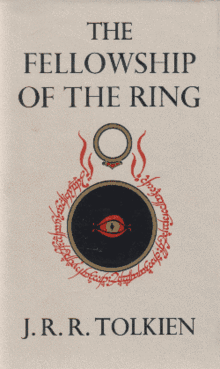The Fellowship of the Ring
The Fellowship of the Ring is the first of three volumes of the epic[2] novel The Lord of the Rings by the English author J. R. R. Tolkien. It is followed by The Two Towers and The Return of the King. It takes place in the fictional universe of Middle-earth. It was originally published on 29 July 1954 in the United Kingdom.
 First edition | |
| Author | J. R. R. Tolkien |
|---|---|
| Country | United Kingdom |
| Language | English |
| Series | The Lord of the Rings |
| Genre | Fantasy |
| Set in | Middle-earth |
| Publisher | George Allen & Unwin[1] |
Publication date | 29 July 1954 |
| Pages | 423 (first edition) |
| OCLC | 12228601 |
| 823.912 | |
| LC Class | PR6039.032 L67 1954, vol.1 |
| Preceded by | The Hobbit |
| Followed by | The Two Towers |
The volume consists of a foreword, in which the author discusses his writing of The Lord of the Rings, a prologue titled "Concerning Hobbits, and other matters", and the main narrative in Book I and Book II.
Title and publication
Tolkien envisioned The Lord of the Rings as a single volume work divided into six sections he called "books" along with extensive appendices. The original publisher decided to split the work into three parts. It was also the publisher's decision to place the fifth and sixth books and the appendices into one volume under the title The Return of the King, about Aragorn's assumption of the throne of Gondor. Tolkien indicated he would have preferred The War of the Ring as a title, as it gave away less of the story.[3]
Before the decision to publish The Lord of the Rings in three volumes was made, Tolkien had hoped to publish the novel in one volume, possibly also combined with The Silmarillion.[4] However, he had proposed titles for the individual six sections. Of the two books that comprise what became The Fellowship of the Ring the first was to be called The First Journey or The Ring Sets Out. The name of the second was The Journey of the Nine Companions or The Ring Goes South. The titles The Ring Sets Out and The Ring Goes South were used in the Millennium edition.
The title The Fellowship of the Ring means the nine companions, nine walkers in opposition to the nine black riders, who set out on the quest to destroy the ring. They were the hobbit and ringbearer Frodo Baggins and his gardener Sam Gamgee, the wizard Gandalf, the elf Legolas, the dwarf Gimli, the men Aragorn the ranger and Boromir of Gondor, and the young hobbits Merry Brandybuck and Pippin Took.
Contents
The volume contains a Prologue for readers who have not read The Hobbit, and background information to set the stage for the novel. The body of the volume consists of Book I: The Ring Sets Out, and Book II: The Ring Goes South.
Critical reception
The poet W. H. Auden wrote a positive review in The New York Times, praising the excitement and saying "Tolkien's invention is unflagging, and, on the primitive level of wanting to know what happens next, The Fellowship of the Ring is at least as good as The Thirty-Nine Steps."[5] However, he said that the light humour in the beginning was "not Tolkien's forte".[6] The volume was favourably reviewed by nature writer Loren Eiseley. The literary critic Edmund Wilson however wrote an unflattering review entitled "Oo, Those Awful Orcs!"[7]
References
- "The Fellowship of the Ring". Between the Covers. Retrieved 2 December 2010.
- Jane Chance [Nitzsche] (1980) [1979]. The Lord of the Rings: Tolkien's Epic. Tolkien' Art: A Mythology for England. Macmillan. pp. 97–127. ISBN 0333290348.
- Carpenter, Humphrey, ed. (1981), The Letters of J. R. R. Tolkien, Boston: Houghton Mifflin, #140, ISBN 0-395-31555-7
- The negotiations between Tolkien and Allen & Unwin over the publication of The Lord of the Rings and the possibility of including The Silmarillion (which was still incomplete) are covered passim in the entries for 1950 through 1952 in the Chronology of The J.R.R. Tolkien Companion and Guide by Scull and Hammond (p. 355–393). Several of Tolkien's letters in The Letters of J.R.R. Tolkien, edited by Humphrey Carpenter, touch on this matter, notably Letters 123, 124 (in which Tolkien explicitly desires to have the works published together), 125, 126, 131, and 133.
- Auden, W. H. (31 October 1954). "The Hero Is a Hobbit". The New York Times. Retrieved 24 August 2018.
- Auden, W. H. (22 January 1956). "At the end of the Quest, Victory". The New York Times. Retrieved 24 August 2018.
- Wilson, Edmund (14 April 1956). "Oo, Those Awful Orcs!". The Nation.
External links
| Wikiquote has quotations related to: The Fellowship of the Ring |
- The Fellowship of the Ring at the Internet Book List
.jpg)